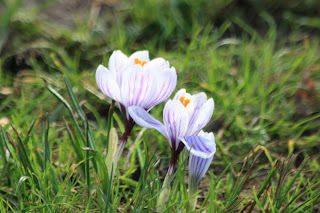
Subtitled Everyday Solutions to Tomorrow's Problems this book offers a good introduction to how we can change our habits to become more eco-friendly. The book is arranged into chapters that focus on: Indoors; Outdoors; Transport; On Holiday; At Work and Food and Drink with a brief introduction that outlines the history of eco-awareness and stresses that, though this is a global issue, individual actions can make a difference.
The book is beautifully designed featuring illustrations by Melvyn Evans. There's a good balance between information and advice, for example information on how drains work and advice on how to avoid clogging them up. There's also a balance between the pros and cons of for example plastic packaging (which though it causes huge pollution problems, does cut down on food waste, which has its own large carbon footprint) and electric vehicles (which have a definite positive effect on the carbon footprint of travel but only if the electricity comes from green sources). On the other hand there are some contradictions, for ecample different opinions on the effects of buying local food being shared in different sections.
The book covers the hidden environmental issue of the amount of energy used in online activities (huge amounts of energy are used by data centres) and how to reduce that (for example it uses less energy to type a website address into your browser directly rather than using a search engine). This section of the book diverted me into emptying my email inbox as an attempt to decrease the carbon footprint of my own online activities.
Other topics include: reducing toxins in indoor air, eco-friendly clothing, how to look after the wildlife in your garden and your wider local area, how to be a responsible dog walker, a useful examination of the ecological impacts of different modes of travel, how to reduce food waste and how to make your office more eco-friendly.
The book focuses on the actions we can take as individuals to reduce our own carbon footprint, but makes the point on several occasions that businesses need to change too, we need to for example recycle but we also need to pressure companies to make products that can be repaired, upcycled or recycled. It's comprehensive in the topics it covers and is an excellent starting point for someone setting out on their journey to reduce their carbon footprint. However it is just that, a starting point. It really doesn't go far enough, we need much more ambition if we are to properly address the climate challenges ahead of us and anyone who is already eco-aware will be disappointed that this book doesn't go further in its suggestions.
COVID_19 Reality Check: For a book written in 2020 it is almost surreal in the lack of reference to the COVID_19 pandemic. Assuming that social distancing will not be a requirement for too much longer gives the book a longer shelf life, but does mean that some suggested ideas are impractical or illegal in current circumstances (getting together with friends for a clothes swap for example was a wonderful idea pre-2020 world but in many countries would now result in arrest!) Similarly a whole chapter on eco-friendly tourism seems almost irresponsible in a time when we shouldn't be tourists at all. (The chapter is however, worth keeping as reference for when tourism becomes realistically sensible again).
The Eco Hero Handbook by Tessa Wardley, published (2021) by Ivy Press an imprint of The Quarto Group.
Disclaimer: I received a free e-book of this title in exchange for an honest review.


















































